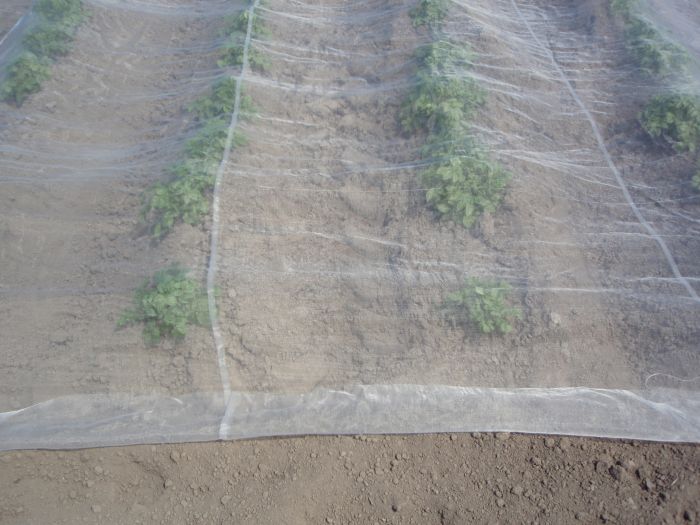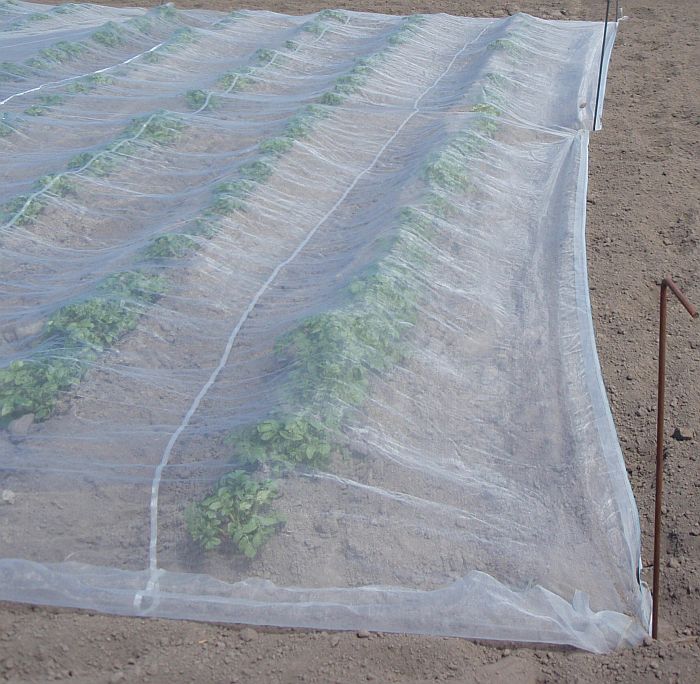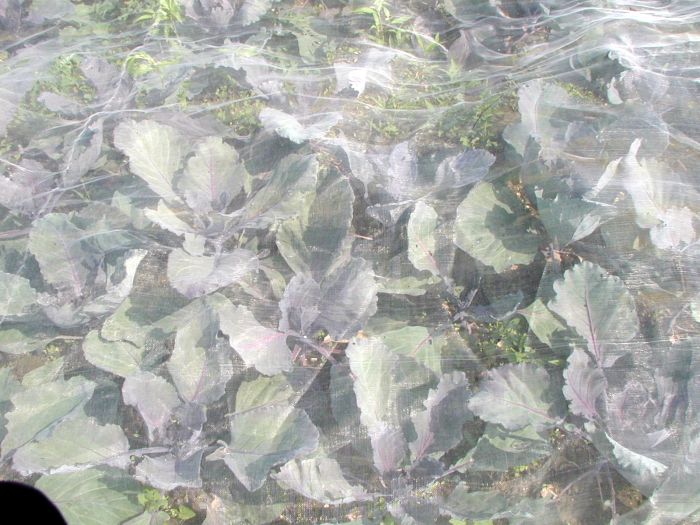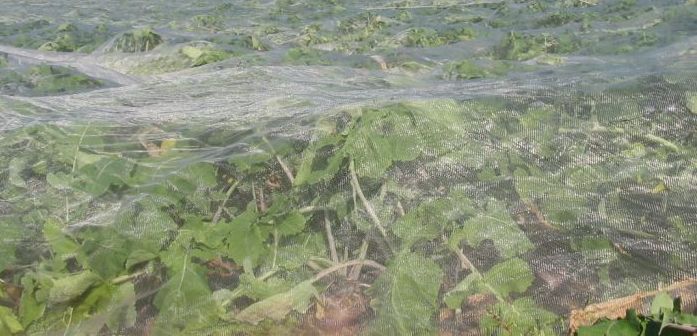Mesh crop covers for, humane / non-lethal, pest control on outdoor crops for home gardeners, lifestyle blockers and market gardeners


Left photo: Comparative yield of Moonlight potatoes grown under mesh (left) and without mesh (right) at the BHU in 2015/16. Right photo: aphid on 0.6 mm mesh.
Please click here for prices and to order.
See below for an extensive range of information on mesh, what it is, what it does, and how to use it.
The Future Farming Centre’s Mesh crop covers for potato blight and pest control research page.
Webpage of media coverage of mesh
Contents
Commercial growers and farmers info
What are mesh crop covers?
Mesh crop covers are not Mikroclima / frost cloth
What crops can I use mesh on?
What pests can mesh control?
Tomato potato psyllid (TPP) – the original reason for research into mesh crop covers
Potato blight control with mesh crop covers: Complete control of potato pests and diseases!
Issues with aphids penetrating mesh on potatoes
Mesh and tomatoes
Customer comments
How do I use mesh crop covers?
Can I cut mesh to length / shape?
How much mesh do I need?
Does mesh give any frost protection?
General FAQ
What crops and pests are mesh crop covers less suitable for?
Why have I not heard about mesh crop covers before in New Zealand?
Photos
Other uses for mesh
Iif your considering testing mesh please contact me charles.merfield@bhu.org.nz 021 0231 8901 as I can probably save you a lot of time and money and happy to have a short chat at no charge. Also there is a short report Mesh crop covers for pest control in commercial crop production that explains the history of mesh crop covers, their benefits and their current use in commercial production.
The use of mesh started in NZ as a means to control the tomato potato psyllid (TPP) on potatoes. However, the use of mesh has now grown far beyond that, such, that some people don’t know about the damage TPP can do to potato, tomato and other solanaceae crops. Here are some links to explain the problems caused by TPP. Landcare Research factsheet. Potatoes NZ TPP myths. Plant & Food Research “Controlling the tomato/potato psyllid in the home garden” (which oddly does not mention mesh!).
What are mesh crop covers?
Mesh crop covers are an organic / non-chemical means of keeping pests off crops, from as small as insects (root flies, caterpillars) to as big as vertebrates (birds, rabbits, possums, cats, dogs, deer) etc.
They work by stopping pests getting to the crop in the first place, a bit like fly screens on a house stop the flies from getting in. They are therefore humane as they don’t kill or otherwise harm pests, unlike ‘sprays’ (even organic sprays such as neem and pyrethrum) and other chemical deterrents.
They are very lightweight (90 grams / square meter) so are directly laid on crops without any need for support. They were developed in the 1990s in Europe, and have proved to be so effective they are now in widely used across the EU.
Mesh crop covers are not Mikroclima / frost cloth
Mesh crop covers are also completely different to Mikroclima, which is a frost cloth and designed to keep crops warm in cold weather. Mesh crop covers are a pest control cloth, designed to keep pests off while having little effect on under-sheet temperature so it can be used in hot weather as well as cold weather.
What crops can I use mesh on?
Mesh crop covers can be used on just about any outdoor crop, as long as the mesh completely covers the crop down to the ground, for example, potatoes, strawberries, carrots, parsnips, cabbages, cauliflower, broccoli, kale, silverbeet, bush beans, rocket, Asian greens, lettuce, herbs, etc. Some crops are not suitable for mesh, see the section ‘What crops and pests are mesh crop covers less suitable for?‘ below for more info.
What pests can mesh control?
Mesh crop covers can control a very wide range of pests, so many that it is the proverbial ‘one-stop-shop’ for insect and vertebrate pest control. Pests that the 0.6 mm mesh available from the BHU can control includes:
- Flea / leaf beetles (Chrysomelidae)
- Tomato potato psyllid (TPP) (Bactericera cockerelli) but see warning at top of page about potato aphids
- Potato tuber moth (Phthorimaea operculella)
- 28-spotted potato ladybird / hadda beetle (Henosepilachna vigintioctopunctata)
- Green vegetable / shield / stink bugs (Nezara viridula)
- Carrot root / rust fly (Psila rosae)
- Cabbage root fly (Delia radicum)
- Butterflies / caterpillars, eg cabbage whites (Pieris brassicae and Pieris rapae)
- Beetles including weevils
- Birds – esp on strawberries
- Wasps on grapes (this is widely used in Europe)
- Apple and pear leaf curl midge
- Possums
- Rabbits
- Cats, dogs and other domestic pets
- Deer
- and a wide range of other insects and vertebrates.
While mesh can control a very wide range of pests, some are more difficult to control than others. Please see the section ‘What crops and pests are mesh crop covers less suitable for?‘ below for more info.
Potato blight control with mesh crop covers: Complete control of all potato pests and diseases!
Not only can mesh control pests, it can also control the fungal disease potato blight. This is a world first, and internationally important discovery by the BHU Future Farming Centre. Mesh is therefore an almost complete means of pest control on potatoes, i.e. it controls blight, TPP, and potato tuber moth. However, please see the warning at the top of the page about potato aphids penetrating the 0.6 mm mesh and also the proviso in section ‘What crops and pests are mesh crop covers less suitable for?‘.


Effect of mesh on potato blight: green potatoes on left of photos was covered with mesh, brown potatoes with high blight levels on right of photos. Left hand photo courtesy of Scott Lawson, Lawson’s Organic Farms Ltd / True Earth™, Hastings.
Customer comments
“Wondermesh” indeed. The first time I’ve had a potato crop in years!
No more carrot fly….
It worked brilliantly on our potatoes – we waited (for the mesh) and planted late. Had a great crop.
We’ve used it to cover the brassicas too, so it is our all-purpose insect cover
I have used the Mesh now for two years and had marvelous success with my potatoes and tomatoes, as a keen home gardener who prefers to grow organic vegies I would recommend the mesh to anyone wanting natural protection for their garden.
How do I use mesh crop covers?
Mesh crop covers are a preventative pest management tool, i.e. they are not able to get rid of a pest once it is among a crop (unlike chemicals and some biological controls). It is therefore vital that the mesh is placed on the crop before the pest arrives. In most cases this means that the mesh should be laid as soon as the crop is planted or sown.
If there are any pests already on transplants (e.g. caterpillars, flea beetles) they must be controlled before the mesh is put on, otherwise they can proliferate underneath the mesh, safe from predators.
Many insect pests are only active at specific times of the year, outside of which no harm occurs to crops. If you know when a pest is not present in your location, it is possible to leave the mesh crop covers off, until just before the pest arrives. However, your timing must be perfect, because, as noted above, once a pest is on a crop, mesh cannot get rid of it.
Mesh needs to be sufficiently well anchored to the soil to prevent pests sneaking underneath the edges of the mesh, and to stop the mesh being blown away. For small areas the most effective and easy way to do this is to use house bricks and/or stones that weigh about two to three kilograms or more depending how windy your site is. The alternative is to dig mesh in, but this requires more work. For larger areas please see section 6.1 on page 13 of this report (PDF file) on options for anchoring mesh over larger areas.
Can I cut mesh?
Mesh is very easy to cut to length or any shape you like with household scissors or a sharp knife.
How much mesh do I need?
You need to have enough mesh to cover not only the width of the crop bed, but also double the height of the crop, i.e., up one side, across the top, and down the other. Avoid trying to cover more crop than the mesh can easily cover, especially fast growing crops such as potatoes, as these will lift the mesh up, even pulling it out from under the stones / bricks holding it down.
How should I store mesh?
When you are not using your mesh on the crop it is best to store it out of direct sunlight. This is because it is sunlight, and especially the UV in sunlight, that degrades the mesh, as it does all other plastics. A garden shed, garage or any other dry location away from direct sunlight is ideal.
Avoid storing wet mesh as it is much heavier and any plant debris caught in the mesh is likely to rot and become unpleasant. Mesh can be attractive to rodents as nesting material with them gnawing holes through it making it of little use. Ensure mesh is protected from vermin during storage.
Does mesh give any frost protection?
Mesh is designed to give the minimum amount of temperature rise under the cover so that it can be used in hot summer weather without cooking crops. It therefore offers a very limited amount of frost protection – about 1C. In the experiments at the BHU it increased in the maximum temperature by 3°C and average temperature by an increase of 1°C.
Information on sucesses with mesh on tomatoes
The March 2017 Get Growing magazine has a great article on using mesh to grow tomatoes with exceptional results. It looks as if concerns over pollination are not coming true and that growing your protected tomatoes under mesh is the way to a great crop.
October 2015 NZ Gardener magazine has a another great article on the successful use of mesh for growing tomatoes. I have also had a number of customers contact me also reporting that they have had excellent crops of tomatoes, even their best crops, using mesh. There is also research from Israel, where they use mesh instead of plastic sheet on their polytunnels, that mesh is reducing tomato blight in experiments, the same as it reduces potato blight in our experiments.
Information about potato aphids penetrating 0.6 mm mesh.
In the 2016-17 field trial we have consistently found aphids penetrating mesh. We now believe that the winged adults are landing on the mesh and then smelling / tasting the potatoes so they don’t fly away and then produce nymphs (babies) which are small and soft enough to get through the mesh. Once inside and protected from natural predators they can multiply to problem levels. The recommended solution that commercial organic growers are doing is to leave one edge or end of the sheet open so if aphids do get in the predators can get in also. If you do get an aphid outbreak then it is best to take the cover off for a couple of days and then put it back on, thus trapping some predators under the mesh with the aphids. Leaving the mesh off for a couple of days wont allow many TPP in, and, we have shown that due to the UV light blocking effect of mesh, TPP don’t like it under the mesh, so unlike aphids, if you do get a few TPP underneath, they wont cause much damage, unlike the aphids. It is still a good idea though to avoid having any plants that host potato aphids growing on the outside of mesh, to avoid a green bridge.
Mesh is still just as effective at controlling all the other pests listed on this page.
General FAQ
How long do mesh crop covers last? The mesh has three year guarantee, but, in Europe commerical growers get up to 15 years out of sheets, so you can expect mesh to last at least a decade in NZ.
Can rain get through the mesh and can I water / irrigate through it? Yes, rain and water just go straight through the mesh, and as it improves the micro-climate crops may need less water.
Can I apply liquid feeds and fungicides through the mesh? Yes, any water based material such as liquid fertilisers / feeds and fungicides can be applied through the mesh.
How much sunlight gets through the mesh? Mesh allows about 85% of sunlight to penetrate, and as sunlight is generally not the limiting factor for plant growth in NZ, an approx 15% reduction in light levels is unlikely to have any negative impact on the crop. Water and nutrients are most likely to be the limiting factor for crop growth.
What effect does mesh have on wind among the crop and ventilation? Mesh provides about a 25% reduction in wind blowing through the crop, which can provide a significant improvement in crop microclimate through reduced wind buffeting, while mesh is sufficiently porous that it ventilates freely and therefore has negligible effect on under-sheet humidity.
What crops and pests are mesh crop covers less suitable for?
While mesh is very versatile, it is not miraculous, and there are some pests and crops that it is less effective at controlling or less suitable for.
Mesh will keep out large aphid speices, such as cabbage aphids, but, the 0.6 mm mesh we are selling will not keep out the juvenile forms of small aphids such as potato aphids. Also as aphids reproduce asexually (vivipary) and also very rapidly, it only takes one aphid to get under the mesh to result in an outbreak. If you are going to use mesh for control of large aphid speices it is vital to ensure it is well sealed to the soil / ground, e.g. with lots of bricks or rocks. Conversely, if you do get aphids under the mesh, you need to created a gap around the edge of the mesh to allow beneficial insects such as ladybirds, hoverflies, and parasitoid wasps to get under the mesh to control the aphids. Also to minimise the chance of juvenile aphids getting through the mesh avoid having a ‘green bridge’ i.e., having plants growing against the outside of the mesh.
If you do have problems with aphids it is also possible to introduce biological control agents under the mesh to control them, the same as is done in polytunnels and glasshouses. Ladybirds are good aphid predators and will also eat other pests as well. You can either collect your own ladybirds to put under the mesh and there are also commercial suppliers such as BioForce that supply them. This is neither an endorsement of BioForce nor is the non-inclusion of other suppliers a non-endorsement of that supplier.
Very tall crops, i.e. sweetcorn, are a bit more challenging, especially as they are also very fast growing. Options include using two pieces of mesh, side by side to ensure the crop is fully covered. See also the section ‘How much mesh do I need’. It is also difficult to put mesh directly on supported crops, such as climbing / indeterminate tomatoes. However, we are getting increasing numbers of reports (including the published articles listed at the top of this page) where people have been using mesh on tomatoes using large cloches or building frames or even using it on tunnel frames and have been getting excellent, even their best, crops of tomatoes. This may be due to the blight inhibiting effect of mesh and also the improved microclimate. Mesh is also being used on vines to keep wasps off the grapes.
Most crops are sufficiently strong to be able to directly support the mesh, even from seedling stage, however, a few are not strong enough, e.g. young leeks, in which case, the mesh can be used with a cloche system, or any means of supporting the mesh above the crop until the crop is strong enough to support the mesh by itself.
Some crops require insect pollination, especially by honey bees, and mesh covers are as effective at keeping pollinators out as pests! In such cases it will be necessary to take the mesh off when the crop requires pollination or use an alternative means of pollination. This is apparently not the case with tomatoes as increasing numbers of people are growing tomatoes inside mesh cages / tunnels and getting excellent results, even the best crops they have ever had. There may well be sufficient wind and other physical movement of the plants to ensure pollination.
Why have I not heard about mesh crop covers before in New Zealand?
The use of mesh crop covers in NZ was pioneered by the BHU Future Farming Centre for organic / non-chemical control of Tomato Potato Psyllid (TPP) on potatoes. Mesh manufactures are now selling mesh in NZ, however, importers are only selling commercial quantities (hectares) to farmers and growers, so the BHU is selling mesh of a suitable size (square meters) as a service to home gardeners, lifestyle blockers and market gardeners.
If you have any other questions please email Merf at ffc@bhu.org.nz
Photos

Newly emerged potatoes

Potatoes after ridging up

Mature potatoes

Carrots

Cabbage

Turnips
Other uses for mesh
We have a growing list of other uses people are finding for mesh, including hand made paper frames and whitebait nets. Mesh is now being used to make wallets from banana trees – see the YouTube video. Let us know any other novel uses you have for mesh!
